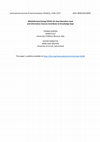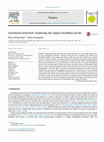Papers by Eszter Hargittai

International Journal of Communication, 2021
As COVID-19 swept across the globe, disrupting people’s lives through lockdowns and health concer... more As COVID-19 swept across the globe, disrupting people’s lives through lockdowns and health concerns, information about how to stay safe and how to identify symptoms spread across media of all forms. Using survey data we collected in April 2020 on a national sample of Americans, we tested the knowledge gap hypothesis by examining how people’s education levels relate to their knowledge about COVID-19 as well as their susceptibility to fake news, and whether information sources moderate this relationship. Our findings suggest that a knowledge gap exists, with those with higher education levels displaying higher levels of knowledge. In contrast, education level did not play a role in believing false information. Moreover, higher news consumption through radio, print newspapers and magazines, and especially social media was associated with lower levels of knowledge and more fake news beliefs. However, news media consumption did not moderate the relationship between education and either knowledge or fake news beliefs, meaning that the media did not explain the education-based knowledge gap during the early months of the COVID-19 pandemic.

Facebook and Academic Performance: Reconciling a Media Sensation with Data
A recent draft manuscript suggested that Facebook use might be related to lower academic achievem... more A recent draft manuscript suggested that Facebook use might be related to lower academic achievement in college and graduate school (Karpinski, 2009). The report quickly became a media sensation and was picked up by hundreds of news outlets in a matter of days. However, the results were based on correlational data in a draft manuscript that had not been published, or even considered for publication. This paper attempts to replicate the results reported in the press release using three data sets: one with a large sample of undergraduate students from the University of Illinois at Chicago, another with a nationally representative cross sectional sample of American 14– to 22–year–olds, as well as a longitudinal panel of American youth aged 14–23. In none of the samples do we find a robust negative relationship between Facebook use and grades. Indeed, if anything, Facebook use is more common among individuals with higher grades. We also examined how changes in academic performance in the nationally representative sample related to Facebook use and found that Facebook users were no different from non–users.

Poetics, 2006
While previous work has found cognitive ability to be strongly associated with whether older adul... more While previous work has found cognitive ability to be strongly associated with whether older adults use the Internet, we consider whether cognitive ability also differentiates basic aspects of use. Four measures of use are considered: having high-speed access, length of time since initial household adoption, self-reported time using the Internet, and whether any of the respondent's Internet use involves the Web in addition to email. In all cases, we find associations with cognitive ability, although effects are sometimes mediated to nonsignificance by subsequent attainments, especially education. Given how central social support is to discussions of older adults navigating the Internet, we look also at reports of the availability of such support, and we find that cognition is positively related to respondents having someone available to help them with Internet problems. Taken together, our results suggest strongly that the already cognitively advantaged are much better positioned to reap the potential benefits of online tools to help older adults navigate social benefits and make complicated decisions. #

While the digital inequality literature has considered differences in the online experiences of m... more While the digital inequality literature has considered differences in the online experiences of many population segments, relatively little work has examined how people with disabilities (PWD) have incorporated digital media into their lives. Based on a national survey of American adults, this paper explores this question through considering both barriers to Internet use and the possibilities the Internet offers PWD. Findings indicate barriers for many PWD to accessing the Internet. Those with five of six types of disabilities measured are considerably less likely to be online than those who are not disabled. People who are deaf or hearing impaired to do not lag in Internet access once we account for demographics, Web use skills, and Internet experiences. However, the study also finds evidence that once online, PWD engage in a range of uses of the Internet as much as people without disability. Moreover, PWD take distinct interest in certain online activities, such as sharing their own content and reviewing products and services, pointing to ways they may go online to adapt and respond to the wider inaccessible society. These findings indicate great potential for the Internet for people with disabilities and suggest that moving more of them online holds the potential for considerable gains among this group.
Based on focus group interviews, we considered how young adults’ attitudes about privacy can be r... more Based on focus group interviews, we considered how young adults’ attitudes about privacy can be reconciled with their online behavior. The “privacy paradox” suggests that young people claim to care about privacy while simultaneously providing a great deal of personal information through social media. Our interviews revealed that young adults do understand and care about the potential risks associated with disclosing information online and engage in at least some privacy-protective behaviors on social media. However, they feel that once information is shared, it is ultimately out of their control. They attribute this to the opaque practices of institutions, the technological affordances of social media, and the concept of networked privacy, which acknowledges that individuals exist in social contexts where others can and do violate their privacy.
Succinct Survey Measures of Web-Use Skills
There is a dearth of survey instruments for measuring Internet skills. This paper presents result... more There is a dearth of survey instruments for measuring Internet skills. This paper presents results from additional implementations of a previously-developed index measure. It considers the performance of the original instrument over time as well as shortened versions of it on two surveys of different populations. Drawing on analyses of five different data sets, the paper makes recommendations for various length survey items for measuring people's Web-use skills.
Abstract This article expands understanding of the digital divide to more nuanced measures of use... more Abstract This article expands understanding of the digital divide to more nuanced measures of use by examining differences in young adults' online activities. Young adults are the most highly connected age group, but that does not mean that their Internet uses are homogenous. Analyzing data about the Web uses of 270 adults from across the United States, the article explores the differences in 18-to 26-year-olds' online activities and what social factors explain the variation.
Second-Level Digital Divide: Mapping Differences in People's Online Skills
Abstract: Much of the existing approach to the digital divide suffers from an important limitatio... more Abstract: Much of the existing approach to the digital divide suffers from an important limitation. It is based on a binary classification of Internet use by only considering whether someone is or is not an Internet user. To remedy this shortcoming, this project looks at the differences in people's level of skill with respect to finding information online. Findings suggest that people search for content in a myriad of ways and there is a large variance in how long people take to find various types of information online.
The social, political, economic, and cultural dimensions of search engines: An introduction
Search engines are some of the most commonly accessed websites online (see a listing of the most ... more Search engines are some of the most commonly accessed websites online (see a listing of the most popular online properties at ranking. com, including top spots held by msn. com, google. com, and yahoo. com). Millions of people turn to them to find content on a daily basis (Fallows, 2005), submitting billions of queries each month (comScore, 2007). In fact, search engine use rivals email as the most common activity undertaken by Internet users (Rainie & Shermak, 2005).
Abstract This article expands understanding of the digital divide to more nuanced measures of use... more Abstract This article expands understanding of the digital divide to more nuanced measures of use by examining differences in young adults' online activities. Young adults are the most highly connected age group, but that does not mean that their Internet uses are homogenous. Analyzing data about the Web uses of 270 adults from across the United States, the article explores the differences in 18-to 26-year-olds' online activities and what social factors explain the variation.
Abstract Much anecdotal evidence suggests that Google is the most popular search engine. However,... more Abstract Much anecdotal evidence suggests that Google is the most popular search engine. However, such claims are rarely backed up by data. The reasons for this are manifold including the difficulty in measuring search engine popularity and the multiple ways in which the concept can be understood. Here, I discuss the sources of confusion related to search engine popularity.
The Internet is a critically important research site for sociologists testing theories of technol... more The Internet is a critically important research site for sociologists testing theories of technology diffusion and media effects, particularly because it is a medium uniquely capable of integrating modes of communication and forms of content. Current research tends to focus on the Internet's implications in five domains: 1) inequality (the" digital divide"); 2) community and social capital; 3) political participation; 4) organizations and other economic institutions; and 5) cultural participation and cultural diversity.
The Internet is a critically important research site for sociologists testing theories of technol... more The Internet is a critically important research site for sociologists testing theories of technology diffusion and media effects, particularly because it is a medium uniquely capable of integrating modes of communication and forms of content. Current research tends to focus on the Internet's implications in five domains: 1) inequality (the" digital divide"); 2) community and social capital; 3) political participation; 4) organizations and other economic institutions; and 5) cultural participation and cultural diversity.
Abstract A refined approach to digital inequality requires that in addition to looking at differe... more Abstract A refined approach to digital inequality requires that in addition to looking at differences in access statistics we also must examine differences among Internet users. People encounter numerous hurdles during their online information-seeking behavior. In this paper, I focus on the likelihood that Internet users will make spelling or typographical mistakes during their online activities. Information seeking on the Web often requires users to type text into forms.
This study reports on new media adopters' perceptions of and reactions to the shift from push bro... more This study reports on new media adopters' perceptions of and reactions to the shift from push broadcasting and headlines to the pull dynamics of online search.
Abstract There is a dearth of survey instruments for measuring Internet skills. This article pres... more Abstract There is a dearth of survey instruments for measuring Internet skills. This article presents results from additional implementations of a previously-developed index measure. It considers the performance of the original instrument over time as well as shortened versions of it on two surveys of different populations. Drawing on analyses of five different data sets, the article makes recommendations for various length survey items for measuring people's web-use skills.
Second-level digital divide
Abstract Much of the existing literature on the digital divide-the differences between the" haves... more Abstract Much of the existing literature on the digital divide-the differences between the" haves" and" have nots" regarding access to the Internet-limits its scope to a binary classification of technology use by only considering whether someone does or does not use the Internet. To remedy this shortcoming, in this paper I look at the differences in people's online skills. In order to measure online ability, I assigned search tasks to a random sample of Internet users from a suburban county in the United States.
Abstract Research on how the Internet is diffusing across the population has broadened from quest... more Abstract Research on how the Internet is diffusing across the population has broadened from questions about who uses the medium to what people do during their time online. With this change in focus comes a need for more detailed data on people's online actions. The author provides a method for coding and classifying users' online information-seeking behavior. The author presents an exhaustive list of ways in which a user may arrive at a web page.
By the beginning of the twenty-first century, information and communication technologies (lCl “) h... more By the beginning of the twenty-first century, information and communication technologies (lCl “) had become a staple of many peoples everyday lives. The level oi instantaneous connectivity——-to others and to an abundance of information--aficorded by advances in ICT is unprecedented. With economies increasingiy dependent on ltnowledge-intensive activities, the unequfl distribution of knowledge and in-
Objective. Sociologists of technology propose that not only a technological artifact, as such, bu... more Objective. Sociologists of technology propose that not only a technological artifact, as such, but also patterns of usage should be considered when studying the social implications of technologies. Accordingly, we explore how people's online activities are influenced by users' socioeconomic status and context of use. Methods. We analyze data from the Allensbacher Computer and Technology Analysis (ACTA) 2004 survey with uniquely detailed information about people's Internet uses and context of usage to explore this relationship.









Uploads
Papers by Eszter Hargittai